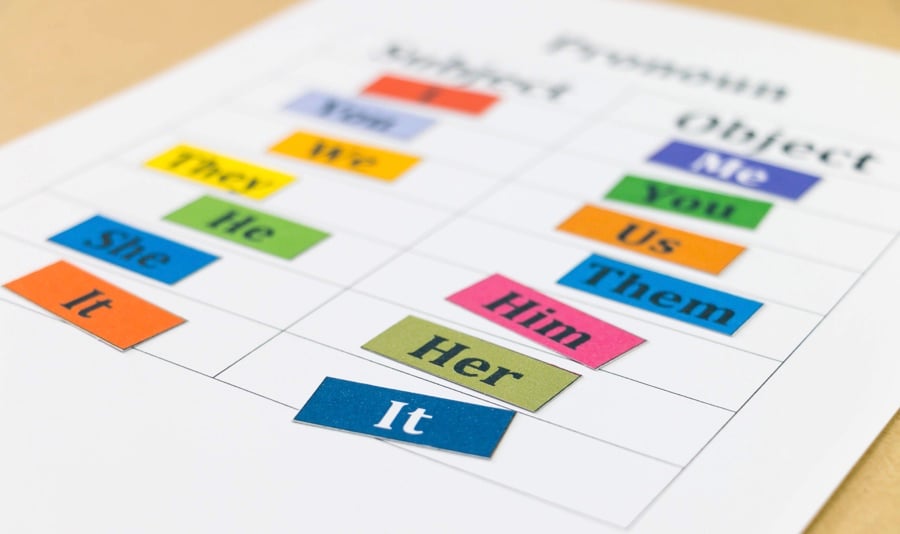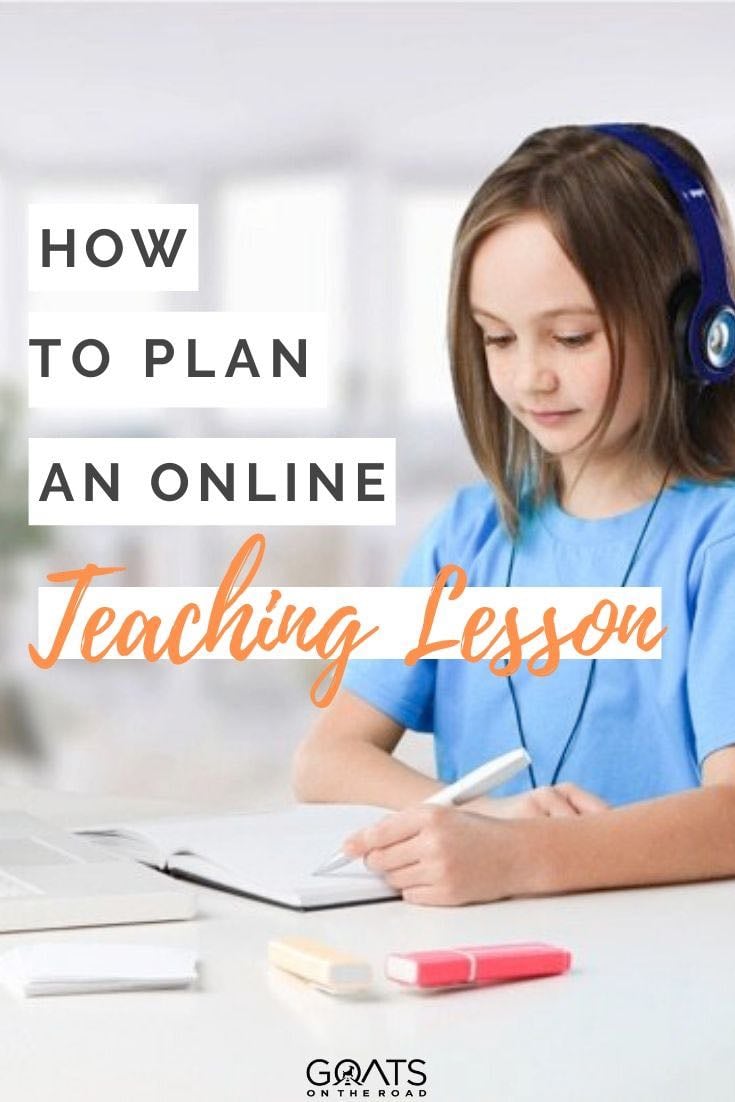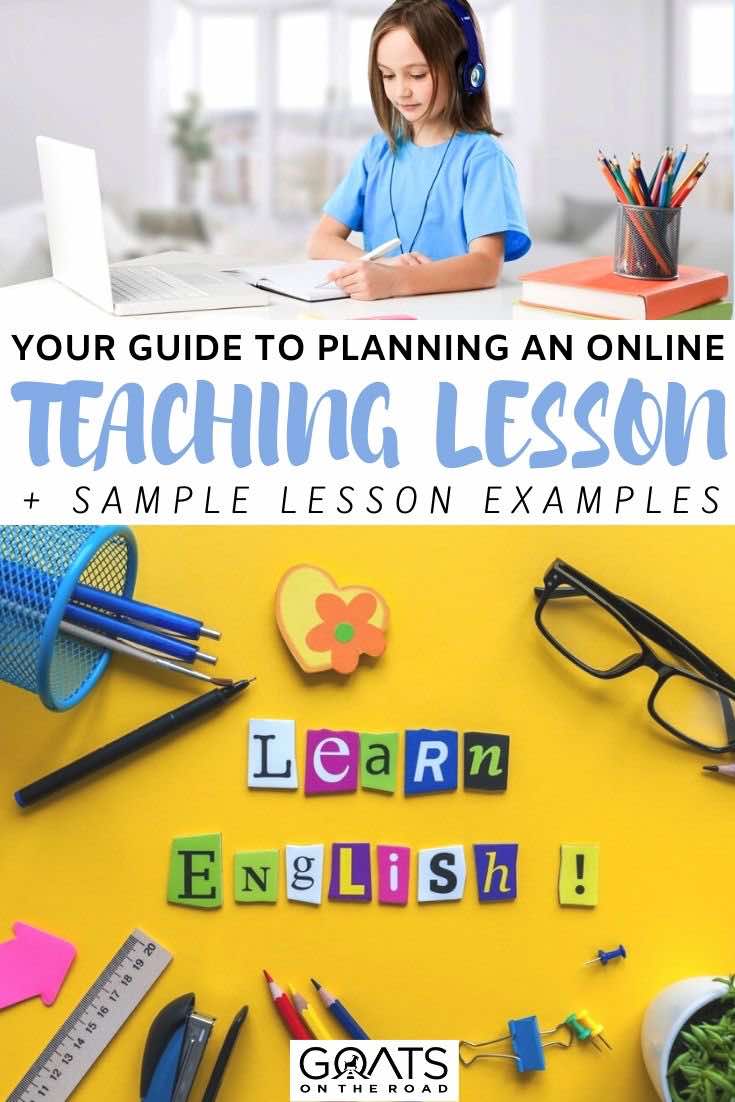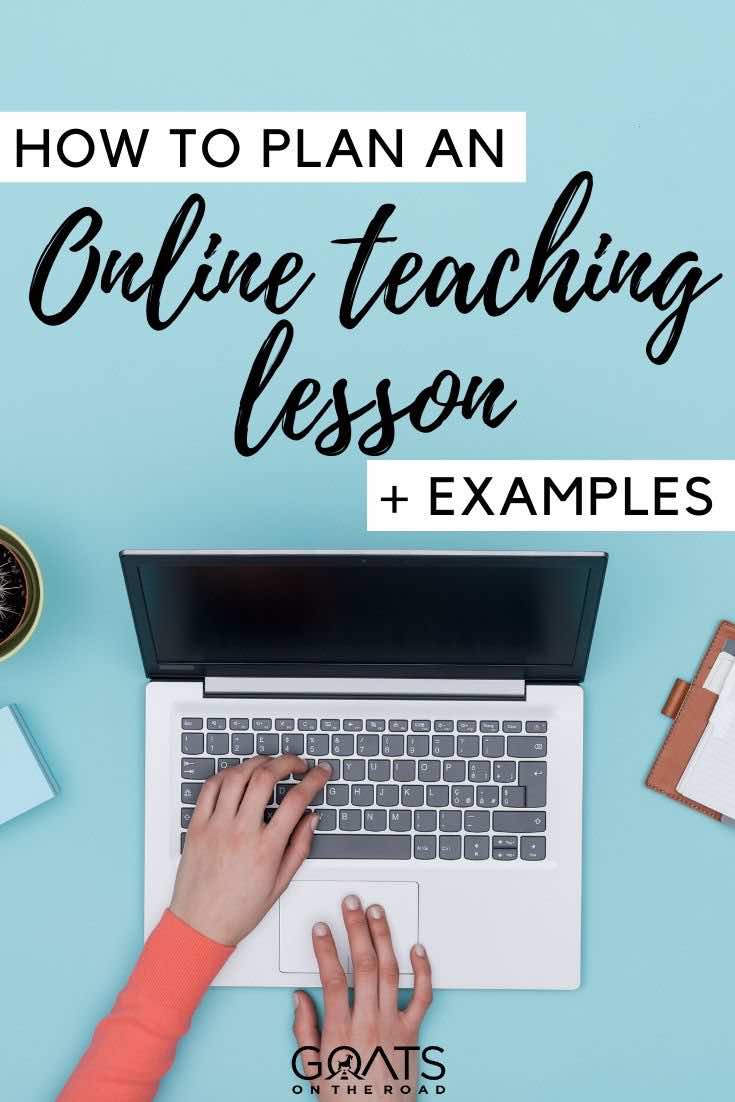You might be wondering how to make an online teaching lesson plan as you embark on your journey to become an online English teacher. Lesson planning for an online English class is fun and allows you to use your creativity.
I’ve been a teacher for a long time, and I’ve taught online since 2017. Here in this post I’ll share with you what I’ve learned are the key elements of a good online English lesson plan, as well as a few sample lessons you can use in your own classroom.
How to Make an Online English Teaching Lesson Plan
If you’ve taken your TEFL course with a reputable company, or if you’re teaching English online with big-name online English teaching companies, they’ll provide you with lesson plans and curriculum.
However, you might find yourself working for a company that doesn’t offer this support. That’s okay though, with a little practice, and after reading this article, you’ll be able to write an engaging lesson plan in your sleep!
Creating and executing your online teaching lessons will go much smoother if you are prepared.
Winging it for 25 minutes in front of the camera won’t be very fun for you or your students, so make sure you have the following components to your lessons.
Good lessons typically have:
- One main objective which outlines what the student will be able to do by the end of the lesson
- Key vocabulary words that will be taught to the student
- Target sentence frames that the students will be able to use in context
- Plenty of opportunities for the student to practice speaking
- Visual and audio elements to enhance understanding
Lesson Objectives
When I was teaching in a traditional classroom, I often wrote the lesson objectives for the day on a sticky note and stuck it to my computer. This helped me make sure I wasn’t getting sidetracked throughout the class.
You can use the same strategy with an online teaching lesson. Write the objective as an “I Can” statement from the student’s perspective on a sticky note and stick it onto your computer.
For example, if you wanted to teach the student how to introduce themself, you might write: “I can introduce myself to the teacher and tell my age and where I’m from.”
Throughout the lesson, reference this main objective to make sure your conversations are pointing the student to this outcome.
Dry Erase Board

A dry-erase board is useful for creating visual aids during your online teaching lesson. Before the lesson, you can write key vocabulary words and target sentence frames on the board.
If you’re feeling really creative, you can write the key vocabulary words for the lesson in one color and write the target sentence frames in another color.
Dry erase boards help you reach more types of learners and give students a reference point they can use throughout the lesson until they are confident they have mastered the material.
Props and Visual Elements
As you create your online teaching lesson plan, think about which visual teaching aids you can incorporate. Many props can be found just by looking around your house. You’ll also want to have an interesting teaching background for your students to see.
For example, if you’re teaching a lesson about food, dig through your cupboards to find some relevant snacks, fruits, and vegetables you can show your student.
If you’re teaching a lesson about clothing, grab a few clothing items from your closet to show the student.
It’s also helpful to have a set of ABC flashcards. Try to get a set that has illustrations for each letter because you can use these pictures to teach other concepts.
I found a pack of ABC flashcards that had animals for each letter at the Dollar Store. I use them all the time for teaching letters and teaching animals.
☞ SEE ALSO: 15 Pros and Cons of Being an Online English Teacher
Audio Elements
Depending on the age of your students, audio elements can also be helpful in enhancing an online teaching lesson. Songs and video clips can demonstrate concepts in a way that reading can’t.
Just remember that if you plan to use a song or video, download it before the lesson time and make sure you can pull it up quickly.
☞ SEE ALSO: Essential Equipment for Online English Teachers
Topics You Can Cover in an Online Lesson

Depending on the level of your student, the possibilities for what topics to cover in your lesson might feel endless. Below are some common English concepts that you could consider covering.
Vocabulary Words
Teach students useful and common vocabulary words. Focus on pronunciation and make sure the student repeats the word at least three times.
You can also have the student practice by reading definitions of key vocabulary words and by spelling their vocabulary words.
Speaking and Conversation Skills
This is one of the most important parts of an English lesson! Most students take classes because they want to be able to converse naturally in the language.
Ask the student simple, open-ended questions whenever possible to encourage them to speak independently.
One way to correct students if they answer with one-word answers is to say the full sentence you’d like them to say, then pause and cup your hand to your ear indicating that you’d like them to repeat.
Grammar
Grammar skills can be taught to more advanced online English students. Cover topics like verb usage and verb tenses to propel student understanding.
To teach grammar, using verb charts is a great start! A simple one looks like this for the verb [to have].
- I have
- You have
- He/She/It has
- We have
- You have
- They have
After you’ve reviewed this chart with the student and read some practice sentences together, encourage the student to practice independently.
One way to help students practice their new grammar skills is to make a worksheet with a word bank and sentences that you can hold up to the camera. For example, the worksheet might have [has] and [have] written at the top. Below, write the following sentences:
- He ____ a ball.
- I _____ a yellow hat.
- She _____ three apples.
Have the student read the sentences and verbally fill in the correct word, [have] or [has].
Reading Skills
Reading skills can be practiced by showing the student sentences or a short reading passage. Depending on the platform you’re using, you could also send your student a small reading passage a few days before the lesson so they can practice.
When the student is reading, make a note of words or phrases that are challenging. After the student finishes, review these words and phrases together by reading them correctly and having the student repeat.
Listening Skills
A fun way to practice listening skills is to show the student a short video or audio clip. After playing the clip 1-2 times, ask the student questions about what they heard.
Advanced Skills
If you teach adult learners or more advanced students, they might want to discuss topics like business English or interview skills.
Practice holding mock interviews and mock meetings with advanced vocabulary to allow your students to prepare for these situations.
☞ SEE ALSO: 10 Things to Know Before Becoming an Online English Teacher
Components of a Good Online Teaching Lesson Plan

I learned the 5E lesson planning format when I was teaching science in a traditional classroom. Even though I used these steps for science lessons, they apply well to online English lessons as well!
For each lesson you teach, although you should try to include each of these steps, it’s ok to skip them, do them out of order, or return to a step several times. Think of lesson planning as a spiral, not a straight line.
Engage (Warm-Up)
The first thing you want to do in your online teaching lesson is to engage the student by activating their prior learning. Get their mind thinking in English and have them use their existing knowledge right away.
Engage activities are good warm-ups. You can ask simple questions, show photos or a short video, or play part of a song.
Explore (We Do Together)
In the explore stage of the 5E lesson plan, the students get more actively involved with the topic. You can think of it as an extension of the engage stage.
In the explore stage, you can can play an English game, teach a song, or have the student repeat a chant based on their level.
Explain (Teacher Does)
During the explain stage, you’ll introduce your student to new material and vocabulary. If you’re teaching vocabulary words, pronounce them first and have your student repeat them. For more advanced students, you can also teach the meaning of different words.
If you’re teaching grammar topics like verb tenses, introduce them to the student here. This is also a great time to pre-teach any difficult words or concepts in a reading passage.
Elaborate (We Do Together)
Give your students a chance to explore the material with your guidance. This could be a reading passage about the topic, a matching game, or a video that the student watches and describes.
During this phase, you should encourage the student to speak independently, but you can assist if they are struggling.
Evaluate (Student Does Independently)
At the end of the class, give the student a chance to show you what they’ve learned. This is an unguided practice where the student shows you that they can use the information they have learned independently.
☞ SEE ALSO: How to Make Money Teaching Online With EF Education First
Sample Online English Lesson Plans
It’s a bit easier to understand how each of these steps work when you see them in practice.
So to demonstrate how these steps look in a real lesson, I’ve put together two lesson plans, one beginner and one intermediate, for you to use as an online lesson plan template.
These lessons are intended to be taught in a one-on-one environment and last about 25 minutes.
☞ See Also: Magic Ears Review: Earn $26/Hour as an Online Teacher
Beginner Sample Lesson: Colors

Materials Needed: Index cards with the colors “red,” “yellow,” “blue,” and “green” written on them in the correct color. Several small items and toys in those colors.
Objective: The student will be able to say the color of different items using complete sentences.
Vocabulary Words: Red, Blue, Green, Yellow
Target Sentence Frames:
- What color is it? It is ____
- What color do you see? I see _____
Engage
For beginner lessons, I like to engage prior English knowledge by asking the student some basic introduction questions in English. I would spend a few minutes asking “What is your name?” “How old are you?” and “Where are you from?”
Encourage students to respond in full sentences answers. For example, instead of just responding with their name, encourage the student to say, “My name is Sally.”
You can demonstrate this by saying the full sentence yourself and pointing to the student to indicate that they should repeat you. Then ask the question again to give them the chance to use the full sentence.
Explain
Show the student each flashcard one at a time. For each card, touch the color and say clearly the color word in isolation.
Point to the student to indicate that they should repeat after you. Have the student repeat the vocabulary word several times.
Practice spelling the new word by demonstrating first, “R-E-D, Red.” Have the student repeat 2-3 times.
Do this for each of the color words in the lesson.
Check for understanding by showing the student a flashcard, pointing to the color, and shrugging your shoulders to indicate that you want them to name the color.
For beginners, using a simple sentence like “What do you see?” also works well. The student should be able to name each color on the flashcard.
Repeat any colors that are challenging.
Elaborate
Now it’s time to extend the vocabulary into full sentences. The student knows the colors, so now you’ll practice using the colors in sentences. Some good sentences to review are:
- “What color do you see?”
- “I see green.”
- “What color is it?”
- “It is red.”
To teach full sentences, I like to have the target sentence frames written on my dry erase board in advance so I can point to the response I want the student to give. Here’s how this looks in practice.
The teacher holds up a red flashcard and says, “What color do you see? I see red.”
The teacher points to the student, still holding red flashcard, “What color do you see?” Then the teachers should cup a hand to the ear to indicate that the student should respond.
Practice these sentences for every color. Then, teach the second sentence, “What do you see?” using the same system.
After the student had practiced both sentence frames for all four colors, it’s time to extend further.
Hold up a red toy or household object like an apple. Ask the student, “What do you see?”
At this stage, it’s okay to assist the student if they are struggling to come up with the full sentence. It’s also a good idea to hold up your dry erase board with the target sentence frames written down so the student can reference the correct response.
Practice holding up different color items, asking the student a sentence, and assisting the student if they need help. The student should be able to respond in complete sentences by the end of this phase in the lesson.
☞ SEE ALSO: Teach English With Qkids: A Step-By-Step Guide
Evaluate
When you have about 5 minutes left in the lesson, it’s time to ensure that the student understands all the material. You’ll end the class by evaluating the student on what they’ve learned.
Hold up each of the flashcards from the beginning of the lesson one by one. Ask the student “What color is this?” or “What color do you see?” and wait for their response.
At this stage, the student should be able to answer the question independently without prompting. However, if the student does struggle, you can always use your handy dry erase board to give them a hint.
It’s always a good idea to end the lesson on a high note.
After your student shows what they’ve learned, give them lots of praise, high fives, and tell them they did a good job. I like to reward my students by singing a silly song together or by playing a game of Tic-Tac-Toe.
No matter what you decide, make sure your student leaves your online classroom feeling good about their efforts.
Homework
If you’re able to assign homework to your students, use their performance in the classroom to create an assignment. If your student struggled with one particular word, send them a link to a video with that word being pronounced so they can practice.
For the lesson above, I would create a quick worksheet with different colored pictures on it. Next to each picture, I’d write “What color is this?” or “What color do you see?” and a line for the student to answer.
For younger students, you can write the words in a word bank and have the student match the color to the picture.
Intermediate Sample Lesson: My Favorite Foods

Here is a sample lesson plan for online teaching to intermediate students.
Materials Needed:
- Pictures of foods or actual foods from around your house, a dry erase board to write target sentence frames.
- Drawing of a verb tense chart for eat/eats.
- Pictures of people eating different foods.
- Flashcards made from index cards with the following words and pictures: Spicy – chili pepper, Sweet – cake, Sour – lemon, Salty – chips
Objective: The student will be able to describe the flavor of different foods and explain in detail which foods they like and dislike.
Vocabulary Words: Spicy, Sweet, Salty, Sour
Target Sentences Frames:
- “How does ____ taste?” The ___ tastes ___.
- What do you like to eat? I like to eat ____ because ____.
Grammar:
- I/you/we/they eat
- He/she/it eats
Engage
For intermediate to advanced students, I welcome them to class and ask them questions about their day during the engage portion. Questions that work well for starting a conversation are:
- How are you?
- What did you do today? (remember to correct answers to past tense if needed)
- What will you do this weekend?
- Did you go to school today?
- What is your favorite class at school?
- Did you see your friends today?
- What do you like to do with your friends?
For this particular lesson, I’d ask a few of the questions above and then ask the following engage question to see what the student already knows:
“What foods do you like?”
Usually, the student will be able to name a few foods that they enjoy. The goal of this lesson is to expand their descriptive vocabulary when talking about foods and help them articulate other types of foods they like.
Explain 1
In this section, you will teach the student different flavor vocabulary words. Start by showing the student each flashcard and pronouncing the flavor word one by one. Have the student repeat each word several times.
Next, guide the student to spell each new vocabulary word. Show them the word on the flashcard and spell the word slowly. Then point to them indicating that you want them to do the same.
If they’ve got it down, you can have the student close their eyes and practice spelling the word from memory.
After the student has a good understanding of how to pronounce each word, you can play a little game to help with their pronunciation.
Say, “When I show you the picture, read the word as fast as you can.” Then show the student each flavor flashcard and see how fast they can read the word.
My students love to see how fast they can go and usually find this activity very funny.
☞ SEE ALSO: 6 Best TEFL Courses for English Teachers
Elaborate 1
Now that the students have a good understanding of each vocabulary word, we will practice matching the words to different foods. We will also practice using the target sentence frames in this lesson.
First, hold up a lemon or other sour food. Hold up the “Sour” flashcard as well. Demonstrate the sentence frame by saying, “How does the lemon taste? The lemon tastes sour.”
Then point to the student and ask “How does the lemon taste?” Cup your hand to your ear to indicate that you are listening for their response.
The student should respond using the target sentence frame you just taught them.
If your student struggles to say the sentence correctly, this is a good chance to bring out your handy dry erase board. Write the question and answer frames that your student should use and hold it up to visually prompt the student.
Repeat this for several different foods, asking the student how they taste and prompting them with the flashcards. Once your student seems to have it down, try asking the sentences without holding up the flavor flashcards.
For the second part of the lesson, the student will use these flavor words to elaborate on their opinions about certain foods.
Start by demonstrating the question and answer frame to the student. Say, “What do you like to eat? I like to eat pizza.” Then point to the student and say, “What do you like to eat?”
The student will tell you about the food they like, and from there you can ask follow-up questions like, “How does ___ taste?” The student should be able to use their flavor words from earlier to explain how their favorite foods taste.
You can also ask questions like
- What is your favorite sweet/salty/sour/spicy food?
- Do you like spicy food?
- Name three salty foods
- How does a cookie taste?
☞ SEE ALSO: Teach English in Japan – A Guide to Finding Jobs
Explain 2
Next, you’ll introduce the student to the new grammar in this lesson by showing them the verb chart for the present tense verb: to eat.
Read the following while pointing to the line in the verb chart and have the student repeat
- I eat
- You eat
- He eats
- She eats
- It eats
- You eat
- We eat
- They eat
Elaborate 2
Practice using the verb tenses by asking the student questions while showing them the verb chart. Hold up the picture of people eating different foods.
Point to different people in the picture and ask:
- What does he eat?
- What does she eat?
Mime eating foods from Part 1. Ask the student, “What do I eat?”
Make sure the student is answering using the correct verb tense. If they make a mistake, hold up the verb chart and point to the correct answer while reading it yourself. Then point to the student to indicate that they should repeat after you.
Evaluate
To evaluate the students’ learning in the lesson, start by holding up different food items and asking the student, “How does __ taste?”
The student should be able to answer using the flavor vocabulary words from the lesson, but if they struggle you can hold up your dry erase board with the sentence frames or your flashcards to assist them.
Show the picture of people eating one more time and ask, “What does he eat?” or “What does she eat” while pointing to people in the image.
Conclude class by asking, “What do you like to eat? and follow up with “How does __ taste?” Remember to praise the student for a job well done and end class on a high note with a song, game, or reward.
For older students, the rewards range from a game of tic tac toe or rock paper scissors to me showing them pictures of my pets. After you’ve had a few classes with a student you’ll start to learn what motivates them.
Homework
If you want to give your students an interactive homework assignment, tell them to write down the foods they ate for dinner and label the foods as salty, spicy, sweet, or sour. Have them share their dinner flavors with you in the next class.
Final Tips to Remember

Planning your own online English lessons can be very fulfilling and allow you to give your students more customization than the standard curriculum provided by companies. Remember these tips to give your lessons some extra flair.
Body Language Is Key
Use plenty of body language to communicate with your students. Show them that you’re listening for them to speak by cupping your hand to your ear and pointing to them.
If you don’t have a certain prop for a lesson, mime it as best as you can.
Pictures and Images Go a Long Way
Find a few pictures to accompany each lesson. This can go a long way in helping your students understand the material.
These can also help if your student does very well and finishes the lesson early. You can ask them endless questions about what they see in the image and their opinions of it.
Always Prepare Extra Activities
Like I mentioned above, it’s a good idea to have extra activities on hand in case the student moves quickly through the lesson.
Parents are often paying you for a set amount of time. This means that they expect instruction for the entire duration of the class.
Here are a few quick activities you can keep on hand:
- Make a tic-tac-toe game with vocabulary words in each space. Show it to the student and they have to read the word to put their mark in a space
- Have extra pictures of the lesson topic to discuss with the student.
- Write all the lesson vocabulary words and definitions on a piece of paper. Hold it up and have the student match the two.
FAQs About Online Teaching Lesson Plans
Still have some questions about how to plan your online classes? Check out the following FAQs.
For most subjects, your online teaching lesson plan will need objectives, materials, step-by-step activities, and information about the students.
Your online ESL teaching lesson plan should include one main objective, key vocabulary, target sentence forms, opportunities to practice speaking, and visual and audio elements that make use of technology.
There are many formats available, and often the company you work for will provide a format. They always include objectives, step-by-step activities, and information about the class and students.
The 5E lesson plan format involves 5 steps: engage, explore, explain, elaborate, and evaluate. I describe each step in detail in my post above about online teaching lesson plans.
If I had to sum it up in two words, I’d say prepare and engage. Make sure all the steps of your online teaching lesson plan are in place before you begin. And during your lesson, try to get your students to speak as much as possible.
Have Fun Making Your Online Teaching Lesson Plan
Online teaching can be a very fun experience for teachers and students! Make sure you’re prepared and remember to go with the flow.
Write lessons about topics that interest you and your students will be thrilled to see what you create.
Images in this post are courtesy of Shutterstock, a website filled with beautiful royalty-free images and videos. Click here to learn more about Shutterstock.
Like This Article? Pin It!



The post How to Plan an Online Teaching Lesson in 2023 (with Examples) appeared first on Goats On The Road.





Recent Comments